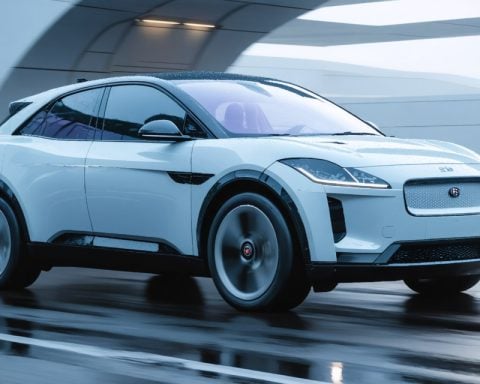- Electric vehicles (EVs) contribute less pollution but can damage roads designed for lighter gas-powered cars due to their heavier batteries.
- The Highway Trust Fund (HTF), reliant on gas tax revenue, faces insolvency amidst growing EV adoption and improved fuel efficiency.
- The Fair Sharing of Highways and Roads for Electric Vehicles (SHARE) Act proposes a manufacturer-level fee for EVs to ensure they contribute to road maintenance funding.
- Additional fees are suggested for EVs with batteries over one-half ton due to their increased wear on infrastructure.
- This approach aims to balance the benefits of electrification with the need for sustainable infrastructure funding.
Gleaming electric vehicles cruise the roads with a promise of a cleaner future, but beneath the smooth hum of their engines lies an unexpected strain on America’s roadways. The Biden administration’s push for widespread adoption of electric cars has unveiled a hidden paradox: while these vehicles cause less pollution, they are inflicting considerable damage to infrastructure designed for lighter gas-powered cars.
At the heart of the issue is the Highway Trust Fund (HTF), America’s primary source of road repair funding. Traditionally, this fund has been fueled by the gas tax—a flow of coins linked directly to the gallons guzzled by commuters across the country. However, the rising prevalence of fuel-efficient and electric vehicles has thinned this revenue stream. The HTF now teeters on the brink of insolvency, even as the heavy batteries of electric vehicles—sometimes up to three times the weight of traditional engines—add substantial wear and tear to highways.
Acting to address this imbalance, a new legislative proposal emerges: the Fair Sharing of Highways and Roads for Electric Vehicles (SHARE) Act. This plan seeks to tether electric vehicles to the HTF in a way they haven’t been before. It proposes a fee, tagged at the manufacturer’s level, ensuring that EVs contribute to road maintenance costs just as gas-powered vehicles do. For heftier EVs with batteries surpassing the one-half ton mark, additional fees would account for the extra pressure exerted on the roads.
The takeaway is clear: as America steers towards an electric future, fairness must guide our path. Ensuring EVs contribute equitably to infrastructure funding is crucial to maintaining the roads that lead us forward.
The Hidden Costs of Electric Vehicles: How EV Adoption Strains U.S. Roadways
Introduction
The push towards a cleaner, greener future with electric vehicles (EVs) has uncovered an unexpected challenge: increased strain on America’s roadways. While these vehicles undeniably reduce emissions and dependency on fossil fuels, their impact on infrastructure funding and road maintenance cannot be overlooked.
How Electric Vehicles Affect Road Infrastructure Funding
Highway Trust Fund (HTF) and Its Challenges
– Traditional Funding Model: The HTF has traditionally been funded by a federal gas tax, utilized to maintain and repair the nation’s roadways. As fuel-efficient vehicles and EVs gain popularity, gas tax revenue declines, threatening the fund’s solvency.
– Weight Impact: The heavier batteries of EVs exert more pressure on roads, contributing to faster wear and tear. For example, some heavy electric vehicles can weigh much more than traditional gasoline vehicles, leading to increased infrastructure stress.
Real-World Use Cases and Industry Trends
– Growing EV Markets: Countries globally are experiencing shifts toward EVs. Norway, for instance, reports that over 54% of new car sales are electric. The United States is similarly seeing increased EV adoption, encouraged by governmental policies and incentives.
– SHARE Act: Legislative measures like the proposed SHARE Act aim to ensure EVs contribute to infrastructure funding, suggesting manufacturers pay fees based on vehicle weight, ensuring fair contribution to roadway upkeep.
Market Forecasts & Industry Trends
– EV Market Growth: Reports indicate that the EV market is expected to grow at a compound annual growth rate (CAGR) of 20-30% over the next decade, increasing the urgency to address infrastructure funding challenges.
– Shift in Transportation Policies: Expect a potential increase in policies mandating fair contributions from EV owners towards road maintenance, impacting manufacturer pricing strategies and market competition.
Reviews & Comparisons
– Pros and Cons of Electric Vehicles:
– Pros: Zero tailpipe emissions, reduced noise pollution, lower operational costs.
– Cons: Higher upfront costs, limited range compared to traditional vehicles, increased weight capacity affecting road durability.
Controversies & Limitations
– Equity Concerns: Some critics argue that imposing fees on EVs might discourage adoption, especially when trying to appeal to environmentally conscious consumers. Balancing environmental benefits with financial sustainability is a delicate task.
– Technological Limitations: As battery technology evolves, EV weights may reduce, impacting future road maintenance strategies.
Security & Sustainability
– Sustainability Impact: As EVs reduce oil dependency, energy sustainability issues arise regarding lithium and battery materials extraction.
Actionable Recommendations
1. Policy Engagement: Stay informed on legislative changes affecting EV taxation and incentives.
2. Evaluate Vehicle Weight and Impact: Consumers should consider the weight of an EV in relation to its environmental and financial costs.
3. Adopt Informed Buying Practices: Understand how upcoming fees and policies could impact overall ownership costs.
Conclusion
Balancing the eco-friendly promise of electric vehicles with the practical needs of road maintenance funding is crucial. As this sector evolves, expect continued debates and adaptations regarding fiscal policies and technological advancements.
For more information on electric vehicles and environmental policies, visit Energy.gov.















